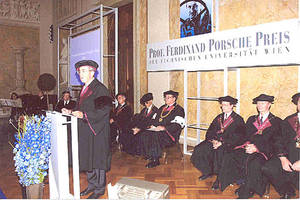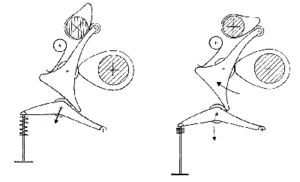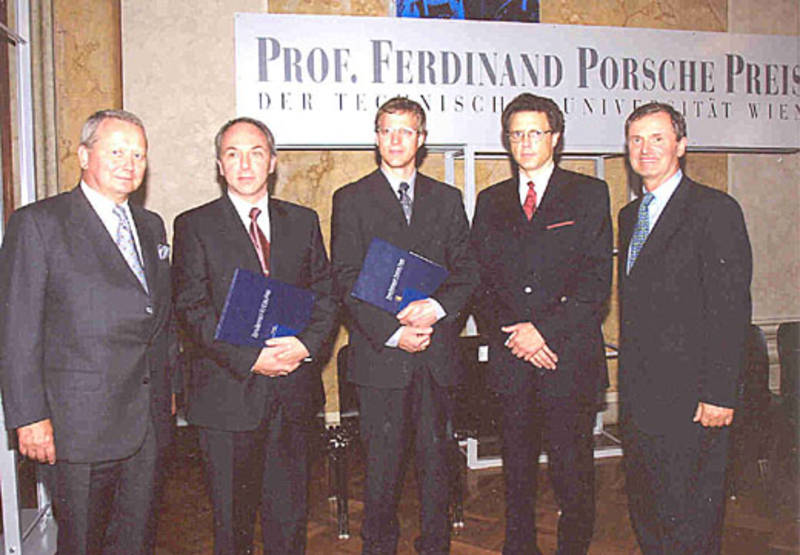Thus, the Porsche Award of the TU Wien has always selected the right achievements and also the right award winners. Things were awarded that were recognized as significant and fully lived up to their test in the automotive industry for the consumer’s benefit.
This year’s award went to Dr. Manfred Klüting and Dr. Harald Unger of BMW for the development of the mechanical, fully variable valve control system Valvetronic.
For many years, solutions have been explored to reduce throttle losses in gasoline engines. Many solutions have been tried. None of these systems succeeded in making the breakthrough to series production. This is where the success of this excellent development lies. It has been possible to bring this design to series maturity and into series production.
How it works: by using step-less adjustment of the valve lift and the closing time, the mixture quantity corresponding to the operating point flows largely unrestricted into the combustion chamber at part load.
The intake valves are closed when the desired filling level is reached in the combustion chamber. The subsequent expansion work up to BDC is largely reversible and thus loss-free.
The high inflow velocity of the mixture into the combustion chamber additionally improves its preparation and the efficiency of the subsequent combustion.
Compared with a conventional valve train, this solution integrates an intermediate lifter between the intake camshaft and the roller cam follower. The intermediate lifter acts like a lever arm to translate the cam movement; see graphic.
Adjustment via an eccentric shaft varies the linkage area of the intermediate lever that engages on the roller cam follower. This results in the desired variation of the valve lift curve.
The eccentric shaft, in turn, is actuated via a worm gear through a servomotor. The accelerator pedal position controls this servomotor. Load control is thus implemented directly at the intake valve.
The entire system is mounted on roller bearings and thus has low friction. Since, compared with the conventional gasoline engine, only a partial lift of the intake valves is required in wide speed ranges, the friction power component of the valve train is reduced since only part of the valve spring forces at the intake have to be overcome. This also helps to improve engine acoustics.
The fuel consumption savings of this system are around 10%, with additional costs of around 15%. Higher demands are made on manufacturing accuracy.
In summary, this is an excellent technical solution that brings the gasoline engine closer to the diesel engine in terms of consumption.
The laureates
Dr. Unger was born in the USA in 1963. After studying mechanical engineering at the University of Kaiserslautern from 1982-1988, Dr. Unger joined BMW as a pre-development specialist in powertrain development. In 1997, Dr. Unger completed his doctorate at the Technical University of Munich under Professor Höhn on “Design and Investigations of the Mechanical Fully Variable Valve Drive”.
Dr. Unger was responsible for the new 4-cylinder Valvetronic engine as a project management engineer in engine development and has been head of the “Engine Concepts in Powertrain Development” department since 2000.
Dr. Unger’s contributions to Valvetronic go back 10 years. In 1991, Dr. Unger conducted concept analyses, literature, and patent research. In 1992, Dr. Unger designed and engineered the Valvetronic components: Camshaft, intermediate lever, eccentric shaft, return springs, and worm gear. A first patent application was filed.
The years 1993-1996 were dedicated to the conceptual and constructive optimization of the components. Further patents were applied for. In 1997, the preliminary development work was handed over to series development.
It was recognized how lengthy and intensive the development work had to be at today’s high level of internal combustion engines to achieve further improvements and excellent results.
Dr. Ing. Manfred Klüting was born in Remscheid in 1955. After studying mechanical engineering at the Technical University of Aachen from 1975 to 1980, Dr. Klüting was a research assistant to Prof. Pischinger, Aachen, and obtained his doctorate in 1986 on the subject of “Flame propagation in fissured combustion chambers of gasoline engines”.
Since 1987, Dr. Klüting has worked at BMW in the fields of thermodynamics, engine control, and drive control. Since 2000, Dr. Klüting has been head of the department “Function Valvetronic Engines”.
Dr. Klüting’s contributions to Valvetronic’s development date back to 1993. In 1993, Dr. Klüting defined the concept of the Valvetronic components from a thermodynamic point of view and the control requirements for the mechatronic peripherals. Preliminary studies were carried out on charge exchange, charge movement, and accuracy requirements.
Starting in 1995, thermodynamic analyses were carried out on the concept engine concerning consumption, combustion process, mixture formation, and emissions. Control functions were developed.
Since 1997, charge cycle designs, combustion chamber concepts, exhaust aftertreatment systems, as well as adjustment requirements of the systems and control functions have been developed. The vehicle application of the 4-cylinder Valvetronic engine was carried out.
This was also a long and intensive development effort that finally led to this solution.


